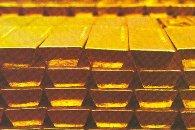 | « Back to article | Print this article |
Should you invest in gold now?
 The best way to invest in gold is in a staggered manner, to take benefit of any sharp corrections that could come in it, says Amar Pandit.
The Reserve Bank of India (RBI) made headlines this week when it announced purchase of 200 tonnes of gold valued at Rs 31,490 crore (Rs 314.90 billion) from the International Monetary Fund (IMF).
The best way to invest in gold is in a staggered manner, to take benefit of any sharp corrections that could come in it, says Amar Pandit.
The Reserve Bank of India (RBI) made headlines this week when it announced purchase of 200 tonnes of gold valued at Rs 31,490 crore (Rs 314.90 billion) from the International Monetary Fund (IMF).
Though RBI said the purchase was done as part of its foreign exchange management operations, a lot of people suddenly took notice and wondered if it was a great time to buy gold.
RBI, like many central banks, is just trying to diversify its foreign exchange reserves, generally held in dollars, into gold. Most central banks around the world are not bullish on the dollar and this move is taken to hedge exposure from a sharp decline in the dollar. This is because gold is not just a commodity but also an alternate currency.
Importantly, gold has consistently been on the rise. On Saturday, it hit the record high of Rs 16,900 per 10 gm in the bullion market. So, as a person, should you buy gold now and how should you invest in gold?
The question is dependent on how much gold do I already own? What is the percentage of gold in my portfolio? Have I bought it for personal consumption or as an investment? At what price did I buy?
It could also be a good time to take profits if you had bought it earlier, as gold has delivered triple-digit returns in the past three years. What about this year? Gold had been in a range between 14,800 and 15,700 for quite some time and it's only now that you see a new high being made.
There is no way one can time the markets and gold is a very volatile asset class, prone to very sharp corrections. Hence, the best way to invest in gold is in a staggered manner, to take benefit of any sharp corrections that could come in it.
There are a lot of merits on why one must hold gold but what is important is the quantum of gold that must be a part of the portfolio and in what form you hold it. Asset allocation is a function of your overall financial goals, liquidity needs, return expectations and risk profile.
There is no thumb rule, but you could allocate anywhere between 5-10 per cent of your assets to gold. This can change on the upper side or the lower side, based on opportunities and the economic scenario.
Most people in India hold gold in the form of jewellry. Additionally, they also hold in the form of physical gold (bars or coins). However, you can also invest in gold through Gold ETFs launched by Asset Management Companies such as Benchmark, Kotak , Reliance, Quantum and UTI.
One of the biggest advantages of investing in Gold ETFs over physical gold is that you can buy this real time, at spot market prices. Since Gold ETFs are in dematerialised form, there is no cost of storage or insurance and there is no fear of any theft. The gold is 99.99 per cent pure and you are assured of its purity, a concern when buying direct gold.
Additionally, Gold ETFs are far more tax-efficient than direct gold, as can be seen from the table below. They attract no wealth tax and long-term capital gains arise when you sell just after a year. On the other hand, physical gold and jewellry will attract wealth tax, and long-term capital gains arise only when you sell after three years; else, it is short-term capital gains.
Besides Gold ETFs, physical gold and jewellry, there is another way to benefit from the price increase of gold. This is by investing in gold equities or gold mining companies and is available in India through DSP ML World Gold Fund and AIG World Gold Fund.
These funds do not invest in direct gold but invest in gold mining companies. The tax treatment for these investments is similar to ETFs and is a good indirect way to take exposure to gold.
These are, however, more volatile investments than gold and can move sharply up and down, as their correlation with the equity market is much higher than that with gold prices.
ETF RETURNS
If you look at the performance , ETFs have outperformed over a period of two years. But, in the past one year, DSP Blackrock World Gold Fund and AIG World Gold Fund have delivered very well. Even when equity markets continued to slide in 2008, gold mining companies funds did exceptionally well, initially. But, then took a beating. However, the fantastic recovery in gold mining stocks helped them deliver a triple-digit return. Even in terms of costs, gold mining funds are the cheapest, with a zero entry load and a 0.75 per cent expense ratio.
So, considering so many choices within the gold asset class, how should you create a gold portfolio? Here's an indicative structure and it could vary from person to person.
INVEST
50-60 per cent of your Gold Assets in Gold ETFs.
30-40 per cent in Gold Mining Companies.
0-10 per cent in physical gold if you like to hold it this way, else give this a miss.
Jewellry is considered a personal asset and not an investment and, hence, should be excluded.
The writer is director, My Financial Advisor
